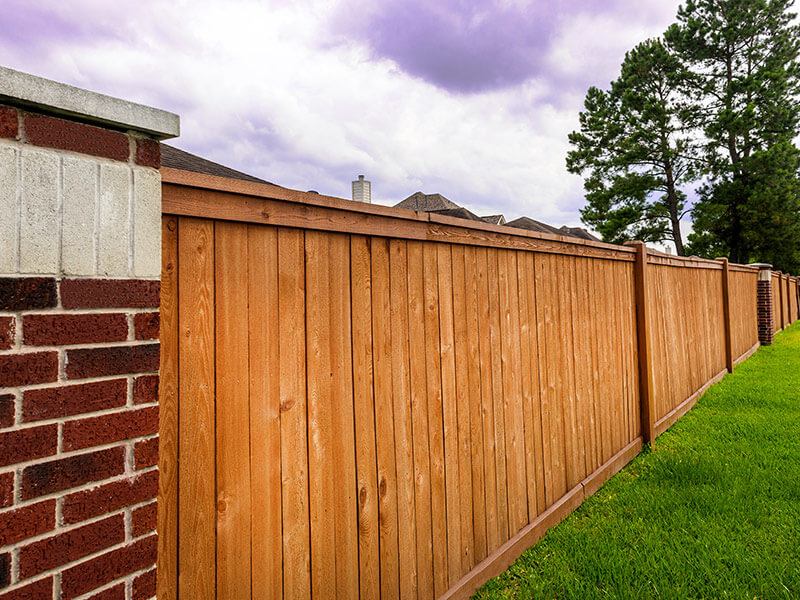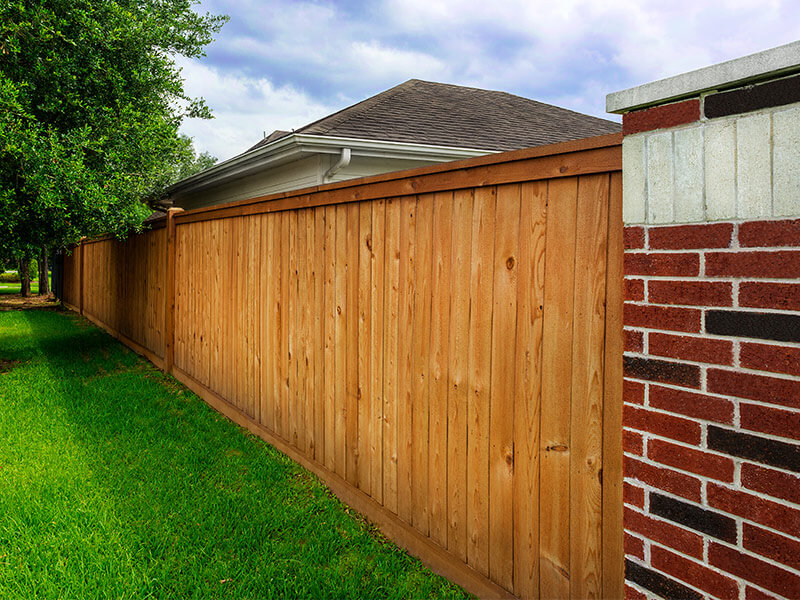How to Care for Western Red Cedar Fences
Care for Western Red Cedar Fences: A Step-by-Step Guide
Are you looking to spruce up your home’s exterior? A beautiful and sturdy western red cedar fence can add quite a bit of charm to any property, but proper care and maintenance are essential for keeping it looking its best. Whether you’re new to fencing or already an experienced homeowner, this guide will walk you through everything you need to know about how to care for western red cedar fences. From deciding which products are best to regular maintenance and cleaning tasks, we’ll equip you with all the information you need to keep your fence looking its best for years to come. Let’s get started!

Quick Breakdown
To properly maintain a western red cedar fence, it is important to seal and stain it annually to prevent weather damage. Additionally, you should inspect regularly and repair any damage as soon as possible to ensure the longevity of your fence.
Inspect Your Fence and Assess Damage
Inspecting and assessing damage to your western red cedar fence is one of the most important steps in caring for it. In addition to checking all of the posts, boards, and rails that make up your fence, you should look carefully at any hardware such as hinges, screws, and bolts to ensure they’re all tight and secure.
If you find sections of your cedar fence are damaged or rotting, determine if repair or replacement is necessary. Replacement is best when large portions of the cedar fence have sustained significant damage. Repair may be more suitable and cost-effective if only a single section has been compromised. There is a debate on whether repairs can extend the life of a fence beyond its expected lifetime, but many professionals suggest replacing sections that are particularly damaged or rotted as this could reduce longevity issues in the future.
Additionally, inspect for any discernible signs that pests or animals have access to your fencing. If woodpeckers and other birds are visible near the fencing, there may be an infestation of insects inside the boards that require action immediately. Plant growth should also be taken into consideration if large shrubs or trees are close by; shrubs or trees can cause unnecessary pressure against your fence’s structure overtime if not trimmed correctly or often enough.
Now that you have inspected your fence and assessed any damage it might have sustained over time, it’s time to move onto the next step: checking the condition of panels on your western red cedar fence.
Check the Condition of the Panels
To keep your cedar fence looking its best over time, it’s important to regularly check the condition of the panels. This can help you identify any potential damage that has occurred, which can be addressed before it becomes a more serious issue. Start by examining each panel up close and carefully checking for cracks, warps, bends or loose nails. Additionally, look for discoloration or signs of wood rot caused by excessive moisture or insect damage.
After inspecting each panel individually, it’s also important to assess its overall stability. Walk along your fence line and check that all posts are still secure in the ground and there is no visible swaying or movement within the frame. If any panels appear to be separating from the posts or leaning outward, use a wrench to tighten any loose bolts or screws and make sure the posts are secured to the ground.
Cedar requires regular maintenance in order to retain its natural beauty and stay in good condition. Depending on your situation, it may not always be possible to do preventive repairs or maintenance after inspecting the panels. Some may argue that when faced with such cases, it is better to replace an entire section of fencing rather than risk further structural damage by attempting a repair. While others might contend that properly restoring one panel is much more cost effective and sustainable than replacing an entire section of fence. Regardless of which option is chosen, however, regular inspection will ensure fences remain in good condition for the long term.
With that task complete, you can move onto properly identifying weather or environmental damage in the next section.
Identify Weather or Environmental Damage
Identifying potential weather or environmental damage is a crucial step to properly caring for western red cedar fences. By regularly inspecting the fence, homeowners and business owners can recognize any issues before they become more difficult and costly to repair down the road.
Be sure to inspect boards for cracking, warping, splitting and sagging to tell if there has been any harm done from exposure to the elements. Additionally, look for evidence of insect activity, such as carpenter bee holes and other galleries that may have been carved out over time by wood-boring bugs.
Fences that are not adequately maintained may develop rot, which can cause major damage or even make them unsafe. If moisture gets into the wood, it can promote further decay. That’s why it’s essential to identify problems early on and take the necessary steps to address them.
An alternative approach is to use stain or a quality sealer product right away when installing your fence, which can protect against outside sources of wear and tear including fading due to UV rays, water damage, staining or discoloration caused by mold or mildew growth, or drying split. The application of a sealant every few years will help ensure the longevity of your fence as well as its aesthetic beauty.
Now that you have identified any weather-related or environmental damage present in your western red cedar fence, it’s important to clean it properly before finishing with a stain or sealer product to keep it looking its best and ensure its longevity. Continue reading for a step-by-step guide on how to clean your western red cedar fence.
- According to the Western Red Cedar Lumber Association, western red cedar fences should be cleaned and sealed every 1-3 years with a water sealer.
- The University of British Columbia recommends using a semi-transparent stain instead of a solid colored paint or heavy sealer as this will allow the wood to breathe while still providing protection against UV damage.
- The Forest Products Laboratory recommends using a water repellent preservative on western red cedar fences to help protect against weathering and decay.
Clean Your Western Red Cedar Fence
When caring for a Western Red Cedar fence, cleaning is an important step that should not be overlooked. Whether you prefer to clean your fence manually with a brush and cleanser, or use a pressure washer, both methods will work effectively to clean off dirt, moss and mildew. Each method has its own benefits, so which one is best for you depends on several factors.
Manually washing the cedar fence with a brush and cleanser allows for more precise cleaning around knots and cracks in the wood. It also takes less time for smaller areas and won’t cause any damage to the wood if done properly. Many people prefer this option because it is less expensive than a power wash as well as more eco-friendly with no runoff wastewater.
On the other hand, some may determine that manual cleaning is not enough and decide to go with pressure washing the fence in order to remove deep-set stains, dirt and mildew that manual cleaning cannot achieve. Although it takes longer to pressure wash than manually clean the fence, it is the most effective way to get rid of tough stains. Pressure washing can also restore the appearance of old cedar fences faster than any other methods do. It is important to keep in mind that it does require experience and, where applicable, should be done by professionals only.
No matter what method you decide on for cleaning your Western Red Cedar fence, the result either way should be a beautiful looking fence that will last for many years. Now let’s move on to talk about more extreme situations and situations when pressure washing may be necessary. Next we will look at how to pressure wash your Western Red Cedar Fence if necessary.
Most Important Summary Points
Cleaning your Western Red Cedar fence is an important step for ensuring its longevity. Manual cleaning with a brush and cleanser can take less time for smaller areas, is more cost-efficient and eco-friendly; however, pressure washing can be necessary to remove deep-set stains and is the most effective way to restore good looks faster than any other method. Proper expertise is required for pressure washing, so in certain cases it should always be done by a professional.
Pressure Wash if Necessary
Pressure wash is an effective way to blast dirt and grime from your Western Red Cedar fence. On the surface, this method seems like the perfect solution for cleaning wood. But pressure washing can also damage wood if it’s done incorrectly on too high of a setting or held at one spot too long. It could also spread rot or fungi that are already present in the wood. If you choose to use a pressure washer, it’s important that you buy the right kind of nozzle and check that it’s compatible with your equipment. It may be a worthwhile investment, as having the wrong nozzle on your pressure washer could actually increase damage to your fence rather than prevent it.
It’s also wise to wet down the fence before you start power washing in order to avoid water drying out too quickly after cleaning, which could lead to more damage due to reduced absorption of protective solutions such as sealant and preservatives applied later during the process.
However, if done correctly, power cleaning can be extremely effective and help make your fence look as good as new without damaging any of its structural integrity or causing further damage from mold or rot.
Now that we have discussed pressure washing, let’s move onto treating your fence in order to prevent rot and mildew from forming.
Treat Your Fence to Prevent Rot and Mildew
The key to wooden fence longevity is treating it with either a sealer or stain. This will protect the fence from warping, fading, and cracking, as well as preventing rot and mildew. Stains are translucent and come in a variety of colors, so you can customize your fence to match the look of your home. A sealer is more protective than a stain and is excellent for fences that are exposed to water or sun. Sealed fences require less maintenance over time than stained fences, but the added protection comes at an additional cost.
You must make sure that the wood is clean before applying either product to ensure proper adhesion. Cleaning can be done with a pressure washer or through manual powered washing. It’s recommended that both sides of your fence be treated, as this will maximize the protection against rot and mildew.
Before deciding which product is best suited for your fence, research the different products available on the market and consult a fencing expert or contractor who has experience with Western Red Cedar fencing. Some places may even sell pre-treated wood, making the job much easier!
Once all preparations are done, this step-by-step guide will show you how to apply either sealer or stain to care for your Western Red Cedar fence properly and help it last for years to come. The next section will discuss how to apply a sealer or stain onto your fence.
Apply a Sealer or Stain
While Western Red Cedar fences are among the most durable fencing materials available, they will require regular maintenance to keep them in top shape. One of the best ways to protect your wooden fence from moisture and fading is to apply a protective sealer or stain.
There are two main types of sealers or stains you can use for your Western Red Cedar fence: oil-based and water-based products. Oil-based products are more durable and provide superior protection against UV rays, and may be your best option if you’re looking for a long-lasting finish. The downside is that these products can be difficult to clean up and may give off strong odors during application, so appropriate safety precautions are important when using them. Water-based products offer fewer advantages in terms of durability, but they’re easier to apply and clean up afterward, as well as being cheaper than oil-based products.
When it comes to which type of sealer or stain is right for your Western Red Cedar fence, it all comes down to personal preference and the look you’re going for. Whether oil-based or water-based, make sure that the product you choose is designed specifically for use with wood fences so that it will penetrate the wood properly and offer adequate protection against moisture, sunlight, and other elements that can damage your fence over time.
Now that you’ve chosen a sealer or stain, it’s time to apply it to your Western Red Cedar fence. To get started, read through all the manufacturer instructions carefully before beginning, as each product may have slight variations in the process. Typically speaking, you’ll want to begin by power washing the surface of your fence to remove any dirt or debris that could prevent even coating later on. After allowing the fence surface to dry completely, proceed with applying an even coat of sealer or stain according to manufacturer directions. Allow plenty of drying time between coats if multiple applications are recommended by the product makers and don’t forget to wear gloves and other protective gear when applying these products as per safety guidelines.
Now that we have discussed how to apply a sealer or stain to your Western Red Cedar fence, let’s move on to our next section: How to Keep Your Western Red Cedar Fence in Optimal Condition.
How to Keep Your Western Red Cedar Fence in Optimal Condition

It is essential to properly maintain a Western Red Cedar fence if you want it to remain in optimal condition. This can include both cleaning and regular trimming for optimal health and longevity of the cedar fence. It’s important to note, however, that these steps are very different from maintenance done on other kinds of fences.
First and foremost, it is important to keep Western Red Cedar fences clean by removing surface dirt with a soft brush or water hose. Additionally, it may be beneficial to occasionally use a wood cleaner and preservative such as Boracare® or Woodlife Coppercoat® to protect the wood from elements like mold and mildew. While there are mixed opinions on whether the use of oil-based cleaners and preservatives helps protect against damage due to wear or UV exposure, many experts argue that using these treatments annually can help preserve the strength of the wood while also reducing its overall weight, since they penetrate deep into the fibers.
Secondly, typically one should not pressure wash Western Red Cedar fences as this can actually damage the texture of the wood and strip away layers of its protection. Instead, pressure washing is only recommended for plastic or vinyl fencing.
Finally, regular trimming is important for preserving the life of a Western Red Cedar fence. Trimming the overgrowth allows more light in, which can help prevent mold growth and minimize discoloration caused by UV exposure. In addition, regular trimming helps promote better airflow so that the cedar has time to dry out in between seasons, which can prevent rot from setting in during humid summer months or colder winter weather.
In summary, proper care and maintenance are crucial in order to ensure optimal longevity and health of your Western Red Cedar fence. A combination of cleaning with non-pressurized water and regular trimming can help ensure that your cedar fence will look beautiful for years to come!
Repair or Replace Damaged Panels
When it comes to repairing or replacing damaged panels of a Western Red Cedar Fence, it is important to take into consideration the extent of the damage, associated costs of repair and replacement, and the overall condition of the fence. Generally speaking, if one or more panels are damaged beyond the point of repair, then replacement is the best option. However, for minor damage such as splintered wood or cracked boards, a repair job can be a viable option.
Repairing a damaged panel can involve filling in cracks with wood filler or fiberglass resin; replacing damaged boards; reinforcing existing boards; and adding new brackets or screws. Depending on the extent of damage and how much effort and time you want to put in to make proper repairs, repair can be a cost-effective way to keep your fence in optimal condition.
On the other hand, if major sections are compromised due to rotting wood, pest infestations, corrosion, mold growth or weather damage to an irreparable degree, then replacement would be recommended. In some cases, repairing one panel might require replacing multiple neighboring panels as well, due to structural integrity issues. In this case, too, a replacement would be preferable.
Replacing a panel is often less time-consuming than trying to repair it if done correctly. It requires removing the old panel with its attached brackets and rails if any; replacing it with a high quality and properly sanded Western Red Cedar panel; securing it in place with appropriate brackets and screws; and ensuring that railings are evenly placed along the top edge of each post.
At the end of the day, whether you choose to repair or replace a damaged panel depends on your assessment of damage and available funds for repairs/replacement. Consider both options and make an informed decision about which approach is best for you.
Conclusion: Regardless of whether you decide to repair or replace your damaged panels within a Western Red Cedar Fence, proper maintenance is key for keeping it in good condition over time. This article has discussed necessary steps that should be taken when caring for such fences. Now let’s discuss how these steps come together towards providing an effective conclusion for maintaining your cedar fence in optimal condition.
Conclusion
When caring for Western Red Cedar Fences, it is important to remember that proper maintenance will extend the life of your fence. Regularly washing, staining, sealing and inspecting your fence will help you get the most out of your investment and ensure it stands tall and looks beautiful for many years to come.
Staining and sealing are essential practices when caring for a Western Red Cedar Fence. When choosing a stain and sealant, be sure to use one that is specifically designed for cedar fences. Doing so will help protect the wood from dirt, water damage, mildew, and other adverse conditions.
Another important task when maintaining a fence is to inspect it regularly for signs of wear or damage. Look closely at the posts, rails, pickets and gates to make sure they are still in good condition and that no major repairs are necessary. In addition, check the area around the fence to make sure there are no trees growing too close, which could lead to pest infestations or structural damage over time.
Ultimately, with regular care and maintenance, a Western Red Cedar Fence can last for decades. With this guide in hand, you should feel confident about extending the life of your fence for many years to come.
Frequently Asked Questions Answered
Could I use a pressure washer to clean my western red cedar fence?
Yes, you can use a pressure washer to clean a western red cedar fence. However, it’s important to remember that the pressure should not exceed 1500 psi, as higher pressures may damage your fence. You also need to make sure you maintain a substantial distance between the nozzle and the wood – at least 22 inches (55 cm) – to ensure that the high-pressure water does not splinter or erode the grain of your western red cedar boards. Additionally, be sure to choose a cleaning solution with bleach specifically intended for use on cedar fences, as some household detergents may dull or damage the wood’s finish.
How often should I seal or stain a western red cedar fence?
When it comes to sealing or staining a western red cedar fence, it is best to do so every two to three years. This will help protect the wood from weather damage and discoloration, as well as give the wood a beautiful natural look. Additionally, by regularly sealing or staining your western red cedar fence, you can prevent insect infestations and rotting of the wood due to moisture more effectively. Sealing or staining should also be done after any repairs have been made to ensure that the customer has a professionally finished product. With proper maintenance and regular sealing/staining, your western red cedar fence will remain in top condition for many years!
What steps should I take to maintain a western red cedar fence?
There are several steps you should take to maintain a western red cedar fence:
1. Clean the surface with a pressure washer: Pressure washing your fence will help remove debris, dirt and mildew that can build up over time. Make sure to use a detergent specifically formulated for wood when pressure washing your fence.
2. Sand away rough spots: If there are any rough parts of the fence, use sandpaper to smooth them out. This will help keep the surface of the fence smooth and prevent any splinters from forming.
3. Apply a sealant or stain: A sealant or stain will protect the surface of the fence from damage caused by weathering and day-to-day use. It also serves as a decorative element to make your fence stand out in any outdoor space.
4. Repair cracks and holes: If there is any major damage to your fence, such as cracks or holes, it is important to repair them right away. Fill the crack or hole with wood filler and allow it to set before painting over it.
5. Check for rotted boards: Over time, some of the boards on your fence may become soft and rot due to moisture in the air or water damage. Replace any boards that have become too soft to be salvaged with new ones, using galvanized nails to secure them in place.
Following these steps will help ensure that your western red cedar fence looks its best for years to come!








